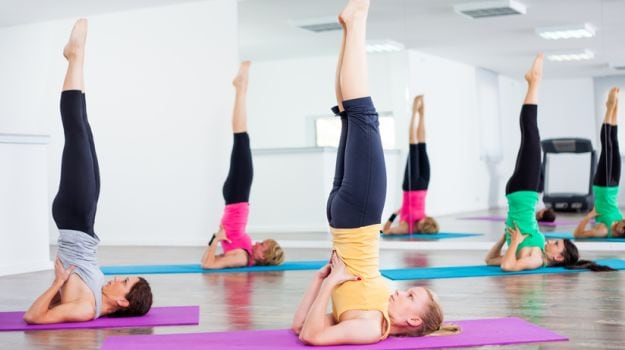
“It is no over-statement to say that if a person regularly practices Sarvangasana he will feel new vigour and strength, and will be happy and confident. New life will flow into him, his mind will be at peace and he will feel the joy of life,” – B.K.S Iyengar.
Sarvangasana derives its name from three different Sanskrit words: ‘sarva’ stands for ‘all’, ‘ang’ means part/s of a body and ‘asana’ denotes posture. This pose engages the entire body below the neck and is considered as an advance stage of yogic practice.
The Benefits
Sarvangasana involves raising the entire body up with the support of your shoulders and hands. It therefore reverses the blood flow. While performing the pose your neck gets locked, as a result the blood flow gets reduced toward the neck and the head. As the blood rushes backwards it benefits people with low blood pressure. It also increases blood flow to the lungs and can aid in respiratory issues.
A photo posted by Bri • like the cheese (@brianadeckard) on Jul 28, 2016 at 8:55pm PDT
“Sarvangasana, popularly known as the shoulder stand has a host of benefits. However, it should be performed under supervision and with much caution. As the posture facilitates blood flow reversion, your upper body gets a gush of more blood. People with low blood pressure benefit from this pose as there is usually inadequate blood supply towards their upper body. The posture helps in thyroid and para-thyroid as well,” noted Yoga expert, Yogacharya Anoop, Chaitanya Foundation.
The shoulder stand aids in proper kidney function and is beneficial for those suffering from anxiety. It is known to uplift mood and balance hormones. If done right after drinking a glass of water, the posture can also aid in correcting bowel issues as well asconstipation.
How to Get into the Pose
Before doing the posture, it is recommended to prep yourself by opening up your muscles by doing a few others poses. Tadasana or simple neck and lower back exercises can be done before getting into the shoulder stand. It is essential to relieve any spinal stiffness before performing Sarvangasana. Here’s how to get into the pose –
– Get into Savasana (corpse pose).
– Now, bring together your feet and place your hand sideways close to your body.
– Bring your legs close to your chest.
– Lift your lower body slowly (similar to Halasana or plough pose).
– Take your hands, place them on your back and slowly lift your legs up.
– Your entire body should be in a straight line with your upper arm supporting your back.
– Hold the pose – begin with 10 seconds – breath normally.
– Now slowly fold your leg from the knee.
– With the support of your hands, get your upper body down.
– Get back on the mat and rest.
– Lie down in Savasana for as long as you held Sarvangasana. Don’t get up with a jerk instantly after finishing it.
Things to Keep in Mind
– The shoulder stand should always be done under supervision.
– Give attention to your neck. If done incorrectly, the posture can cause severe neck injury.
– Make sure you take ample support from your arms; your neck should not be under pressure or pain.
– The pose is not recommended for the elderly, people with high blood pressure, heart issues, slipped disk or any kind of neck, shoulder or back injury.
– Do not get up or come down with a jerk. Do it slowly.
– Follow with Savasana. Do not get up instantly.
– The shoulder stand is an inward bending posture; follow it with backward bending counter-poses such as the cobra pose (Bhujangasana) or the fish pose (Matsyasana).
[“source-ndtv”]
